- Home
- »
- Advanced Interior Materials
- »
-
Self-healing Materials Market Size & Share Report, 2030GVR Report cover
![Self-healing Materials Market Size, Share & Trends Report]()
Self-healing Materials Market Size, Share & Trends Analysis Report By Product (Concrete, Coatings, Polymers, Asphalt, Fiber-reinforced Composites), By Technology, By Application, By Region, And Segment Forecasts, 2024 - 2030
- Report ID: GVR-1-68038-829-9
- Number of Report Pages: 102
- Format: PDF, Horizon Databook
- Historical Range: 2018 - 2022
- Forecast Period: 2024 - 2030
- Industry: Advanced Materials
Self-healing Materials Market Size & Trends
The global self-healing materials market size was estimated at USD 1.94 billion in 2023 and is projected to grow at a compound annual growth rate (CAGR) of 23.5% from 2024 to 2030. The market growth is attributed to the increasing demand for these materials from the construction, electronics, and automotive industries. Self-healing materials are smart materials that can automatically repair damages caused to them due to mechanical impact and restore their functionalities. They are triggered by environmental stimuli, including alterations in UV light and pH, or by mechanical damage, such as a microcrack.
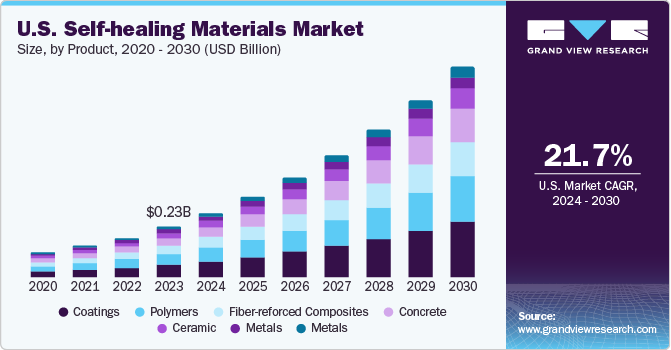
The U.S. self-healing materials market is stimulated by the presence of multinational companies that are engaged in continual R&D work to discover cutting-edge technologies. Implementation of sophisticated expertise supports the expansion of product portfolio that helps to capture untapped markets by increasing customer base.
Self-healing materials are designed to repair damage at initiates at the micron scale, effectively impeding the propagation of the damage and extending the shelf life of the materials. Novel technologies such as hollow glass fibers, optical fibers, and microcapsules are utilized to manufacture specialty composites depending upon the intrinsic and extrinsic types. Therefore, self-repairing is a process that restores the deformed structure by compounds already present with it, analogous to biologically curing process in living organisms.
Microcapsules are present in self-healing materials that rupture when exposed to mechanical dent, causing healing agents to be released to the damaged site. These agents polymerize and mix fixing the damage and reconstruct structural & functional integrity. Microcapsules are made to be robust enough to survive the manufacturing process and consumption of the substances in its intended application.
These materials support reducing the frequency of maintenance costs required to renovate the damage, which is anticipated to be a key factor driving the market’s growth. Self-healing mortar and cement can be utilized in building & construction industry, boosting the demand for self-healing materials over the forecast period.
Market Concentration & Characteristics
The market growth stage is high and the pace is accelerating. Ongoing research and development (R&D) activities present opportunities for innovation in self-healing materials and technological advancements. In addition, self-healing materials benefits from advancements in material science, enabling the development of innovative solutions with enhanced healing capabilities.
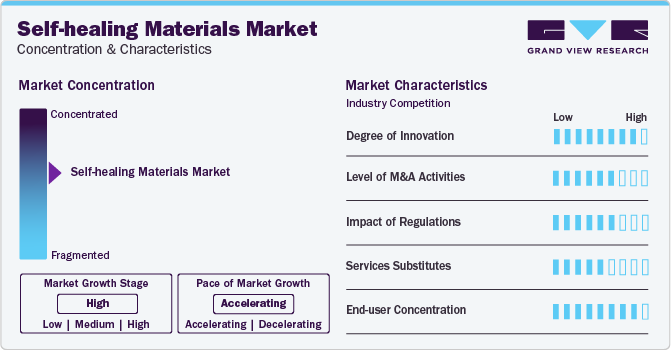
The self-healing materials market is considered highly competitive on account of the presence of many large-scale manufacturers functioning at a regional or global level. To have a competitive advantage, the companies are continuously investing in various strategies such as expansions, product launches, collaborations, mergers & acquisitions, and research & development.
Ongoing technological innovation in already invented products makes it difficult to replace them with new products. However, the presence of conventional inexpensive substitutes can slow the adaption of self-healing materials. Hence, the overall threat of substitutes is expected to be moderate. Furthermore, the end-user concentration is a significant factor in the market since there are a number of end-user industries that drive demand for self-healing materials.
Product Insights
The concrete segment dominated the market with a revenue share of 14.6% in 2023. This can be attributed to the various functional attributes of concrete such as high strength, minimum shrinkage and creep, durability, and cost-effectiveness. The growth in self-healing coatings materials is primarily due to the increasing usage of these products in the industrial sector, including automotive and aerospace. These coatings are used by several industries, such as machinery manufacturing, automotive sector, oil & gas, marine sector, aerospace sector, and consumer goods.
The demand for asphalt self-healing materials is expected to witness strong growth from 2024 to 2030. Incorporating self-healing technology in the road construction and maintenance process has immense potential to develop unique material-engineered technology. Such technology helps in decreasing the unavoidable premature aging of asphalt pavements, and the number of natural resources used to maintain road networks. Furthermore, it helps reduce CO2 emissions and increases road safety. Thus, supporting the overall market growth.
Technology Insights
The reversible polymers segment led the market with a revenue share of 34.1% in 2023, due to the high adoption of this technology in various industries, especially in the medical sector. The surging geriatric population is also expected to bolster the growth.
Stimulus-responsive microstructures are used in manufacturing sensors, micro-actuators, drug delivery systems, membranes, and other such advanced micro devices. Shape memory polymers are used to manufacture shape-memory assisted self-healing (SMASH) coatings. These surfaces aid in structurally healing damaged surface and restore corrosion resistance property.
The demand for microencapsulation technology, which is used in self-healing materials, is likely to gain momentum in the coming years, due to its ability to repair polymeric composites after being injured by mechanical and chemical progressions. Microspheres are present in the compounds that release their contents at an appropriate time by utilizing different release mechanism, depending on the end-use of encapsulated products.
Capsule-based technology is a new alternative to conventional repairing techniques, and its functioning depends on its healing efficiency determination, potential of the existing developed microencapsulated agents, and size of microcapsules.
Application Insights
The building & construction segment led the market with a revenue share of 35.2% in 2023. As construction activities are increasing, especially in Asia Pacific, owing to the rise in construction activities in China and India, the demand for self-healing materials in construction applications is expected to witness significant growth.
The rising socio-economic necessity to build hi-tech infrastructure and buildings in emerging economies of Asia Pacific and Latin America is expected to augment the development of the construction industry over the forecast period, thereby positively influencing the market growth over the forecast period.
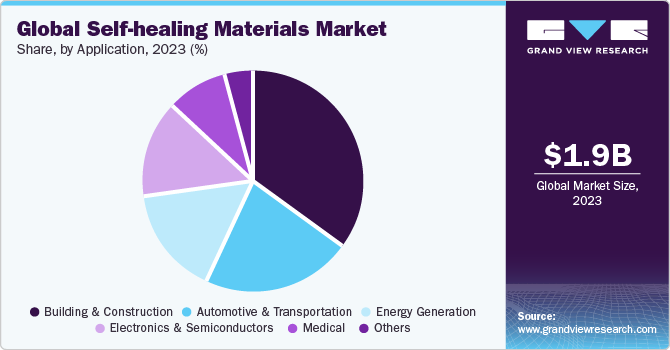
Automotive & transportation is another industry that has witnessed a rise in demand for self-healing materials. Electronics conglomerate such as Samsung and Apple have encouraged the usage of self-healing materials in electronic devices including mobiles, laptops, and desktops, which is expected to boost the product demand.
Automotive OEMs uses an exterior coating applied to automobiles that trigger a curing mechanism when cut or scratched. This coating materials reduces the regular maintenance by healing the scratch mechanically. This is projected to present lucrative market opportunities by accelerating demand for advanced products in the coming years.
Regional Insights
Asia Pacific dominated the market and accounted for a revenue share of 29% in 2023. It is expected to grow at the fastest CAGR of 28.5% by the end of 2030. Higher industrialization, dense population, and rising foreign direct investments in the automotive and electronic sectors are the major factors that support the robust regional growth. Furthermore, growing economic prominence of Southeast Asian countries, including China, India, Indonesia, and Vietnam, owing to the presence of a large consumer base, low labor cost, and abundant resources, increasing per capita income among the middle-income groups is anticipated to fuel the construction sector which is indirectly expected to drive the demand for self-healing materials over the coming years.
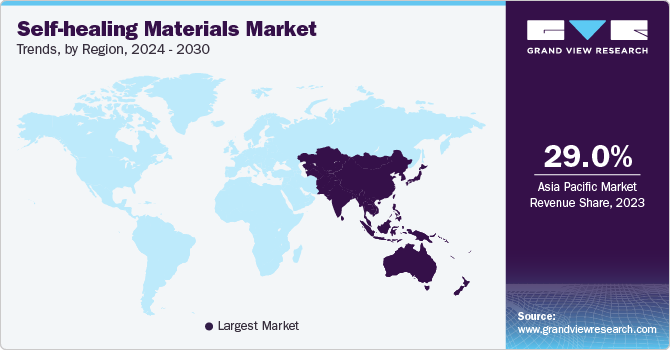
China Self-healing Materials Market
The self-healing materials market in China dominated the Asia Pacific region in 2023. China is one of the significant exporters of automobiles and their components, and this trend is expected to continue as more and more companies such as Volkswagen expand their production capacities in China. The growing automotive sector is expected to contribute to the rising demand for self-healing materials over the coming decade.
India Self-healing Materials Market
India is one of the major developing economies in the world and its construction industry is growing at a significant pace. This is due to the growing population and rapid industrialization in the country. The movement of people from rural to urban areas in search of better opportunities is driving the demand for residential buildings as well as long-term infrastructure projects in urban areas. This is to propel the demand for self-healing materials including self-healing concrete in the country over the coming years.
Germany Self-healing Materials Market
Demand for self-healing materials in Germany is projected to grow at a significant CAGR from 2024 to 2030. The change in demographics of the country owing to the growing proportion of the elderly population in the country is expected to increase the medical industry in Germany in the coming years. This, in turn, is anticipated to surge the demand for self-healing materials in Europe, as the regenerative capabilities of self-healing polymers demonstrate a broad array of applications in the fields of site-directed drug administration, skin grafts, implants, dentistry, and the regeneration of bone and tissue to improve the healing of injured areas.
U.S. Self-healing Materials Market
Demand for self-healing materials is increasing in the country owing to its flourishing aerospace, wind energy, and automotive industries. They are used in the following industries for the production of various components and structures that could heal by themselves, thereby saving time & cost and increasing the product lifespan.
Brazil Self-healing Materials Market
Brazil is the world’s 8th biggest automotive producer and the production of energy-efficient vehicles is increasing in Brazil. Various international automotive companies are investing in Brazil, this is expected to increase the demand for self-healing materials in the country. Additionally, the Brazilian aerospace sector is one of the major product consumers as the self-healing thermoplastic composites can be utilized to virtually restore damaged components to their original condition.
UK Self-healing Materials Market
The demand for self-healing materials in the UK is projected to grow at a significant rate from 2024 to 2030 owing to the flourishing automotive industry in the country. The growth can be attributed to the rising investments in the automotive industry as self-heating coatings is gradually being used in the automotive sector. Moreover, use of self-healing polymers for the production of tires protects them from small cracks and fissures.
Key Self-healing Materials Company Insights
Some of the key players operating in the market include BASF SE, DOW, and Michelin.
-
BASF SE operates in several industries, including chemicals, materials, industrial solutions, surface technologies, nutrition & care, and agricultural solutions. The company operates in 91 countries, including China, South Korea, France, Germany, the UK, and Canada.
-
DOW manufactures chemicals, plastic & agricultural products and provides services across the consumer market. Dow Chemical comprises 32 subsidiaries. Some of these include Arabian Chemical Company Ltd., Blue Cube Holding LLC.; CD Polymers; DOCOMO, Inc.; Dow Business Services; and Dow Chemical China Holdings Pte. Ltd. The markets served by the company include agriculture, automotive, building & construction, energy & water, electronic materials, packaging, industrial and infrastructure.
-
High Impact Technology, LLC and Autonomic Materials, Inc. are some of the emerging market participants.
-
High Impact Technology, LLC is a manufacturer of protective gear. The company’s services include infrastructure and fuel cell protection systems. The infrastructure protection systems include armored concrete, armored louvers, fire cap, battle-ready tank, battle guards, and secondary containment. Whereas, the fuel cell protection system includes a battle jacket, fire cap, and battle-ready tank.
-
Autonomic Materials is a self-healing technology provider for the coating industry. Its products are mainly designed for thermosetting, elastomeric, and powder coatings. The markets served by Autonomic Materials include infrastructure, OEM, machinery & equipment, oil & gas, marine, transportation, water treatment, concrete, aerospace, adhesives & sealants, coil, and structural composites.
Key Self-healing Materials Companies:
The following are the leading companies in the self-healing materials market. These companies collectively hold the largest market share and dictate industry trends. Financials, strategy maps & products of these self-healing materials companies are analyzed to map the supply network.
- The Dow Chemical Company
- Covestro AG
- High Impact Technology, LLC
- Huntsman International LLC
- Michelin Group
- MacDermid Autotype Ltd.
- Akzo Nobel N.V.
- Evonik Industries Corporation
- BASF SE
- NEI Corporation
Recent Developments
-
In October 2023, DuPont launched COASTALUME with U.S. Steel. This is a material specifically designed to withstand coastal environments. It combines self-healing characteristics and strength of U. S. Steel’s GALVALUME and DuPont's Tedlar PVF film barrier, which can withstand saltwater corrosion, cracking, and UV damage, among others. This new product launch is expected to capture the demand for a product for residential and commercial construction in North America.
-
In August 2022, BASF SE introduced RODIM Thermoplastic Polyurethane Paint Protection Film for improved car paint protection. During a 3,000-hour accelerated UV test, the product was shown to have superior resistance to natural elements such as high temperatures and prolonged sun exposure. This is to provide the manufacturers a competitive edge.
Self-healing Materials Market Report Scope
Report Attribute
Details
Market size value in 2024
USD 2.49 billion
Revenue forecast in 2030
USD 8.85 billion
Growth rate
CAGR of 23.5% from 2024 to 2030
Base year for estimation
2023
Historical data
2018 - 2022
Forecast period
2024 - 2030
Report updated
February 2024
Quantitative units
Revenue in USD billion and CAGR from 2024 to 2030
Report coverage
Revenue forecast, company ranking, competitive landscape, growth factors, and trends
Segments covered
Product, technology, application, region
Regional scope
North America; Europe; Asia Pacific; Central & South America; Middle East & Africa
Country scope
U.S.; Canada; Mexico; U.K.; Germany; France; China; India; Japan; Brazil
Key companies profiled
The Dow Chemical Company; Covestro AG; High Impact Technology, LLC; Huntsman International LLC; Michelin Group; MacDermid Autotype Ltd.; Akzo Nobel N.V.; Evonik Industries Corporation; BASF SE
Customization scope
Free report customization (equivalent up to 8 analysts working days) with purchase. Addition or alteration to country, regional & segment scope.
Pricing and purchase options
Avail customized purchase options to meet your exact research needs. Explore purchase options
Global Self-healing Materials Market Report Segmentation
This report forecasts revenue growth at global, regional, and country levels and provides an analysis of the latest industry trends in each of the sub-segments from 2018 to 2030. For this study, Grand View Research has segmented the global self-healing materials market report based on product, technology, application, and region:
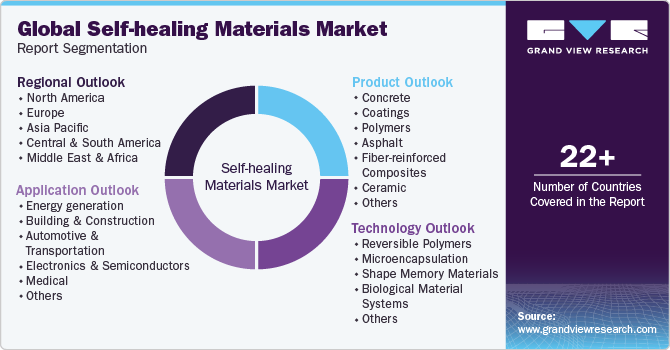
-
Product Outlook (Revenue, USD Billion, 2018 - 2030)
-
Concrete
-
Coatings
-
Polymers
-
Asphalt
-
Fiber-reinforced Composites
-
Ceramic
-
Metals
-
-
Technology Outlook (Revenue, USD Billion, 2018 - 2030)
-
Reversible Polymers
-
Microencapsulation
-
Shape Memory Materials
-
Biological Material Systems
-
Others
-
-
Application Outlook (Revenue, USD Billion, 2018 - 2030)
-
Energy generation
-
Building & Construction
-
Automotive & Transportation
-
Electronics & Semiconductors
-
Medical
-
Others
-
-
Regional Outlook (Revenue, USD Billion, 2018 - 2030)
-
North America
-
U.S.
-
Canada
-
Mexico
-
-
Europe
-
Germany
-
U.K.
-
France
-
-
Asia Pacific
-
China
-
Japan
-
India
-
-
Central & South America
-
Brazil
-
-
Middle East & Africa
-
Frequently Asked Questions About This Report
b. The global self-healing materials market size was estimated at USD 1.94 billion in 2023 and is expected to reach USD 2.49 billion in 2024.
b. The global self-healing materials market is expected to grow at a compound annual growth rate a CAGR of 23.5% from 2024 to 2030 to reach USD 8.85 billion by 2030.
b. Asia Pacific dominated the self-healing materials market with a share of 29% in 2023. This is attributable to the rapid growth in demand for consumer electronics, automobiles, aerospace, and energy generation.
b. Some key players operating in the self-healing materials market include The Dow Chemical Company, Covestro AG, High Impact Technology, LLC, Huntsman International LLC, Michelin Group, MacDermid Autotype Ltd., Akzo Nobel N.V., Evonik Industries Corporation, BASF SE, NEI Corporation
b. Key factors that are driving the market growth include rapid growth in demand for consumer electronics, automobiles, aerospace, and energy generation. The ability of self-healing coatings to provide aesthetic appearance, scratch resistance, and durability is expected to stimulate its demand in various applications over the forecast period.
Share this report with your colleague or friend.
![gvr icn]()
NEED A CUSTOM REPORT?
We can customize every report - free of charge - including purchasing stand-alone sections or country-level reports, as well as offer affordable discounts for start-ups & universities. Contact us now
![Certified Icon]()
We are GDPR and CCPA compliant! Your transaction & personal information is safe and secure. For more details, please read our privacy policy.
We are committed towards customer satisfaction, and quality service.
"The quality of research they have done for us has been excellent."





